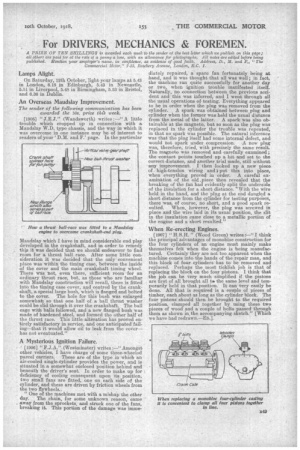For DRIVERS, MECHANICS & FOREMEN.
Page 21

If you've noticed an error in this article please click here to report it so we can fix it.
A PRIZE 0P1 TEN SHILLINGS is awarded each week to the sender of the best letter which we publish on this page all others are paid for at the rate of a penny a line, with an allowance for photographs, All notes are edited before being published. Mention your employer'l name, in confidence, as evidence of good faith, Address. D., 31, and F., The Commercial Motor," 7-26, Rosebery Avenue, London, E.C. 1.
Lamps Alight. •
On Saturday, 12th October, light your lamps at 5.43 in London, 6.18 in Edinburgh, 5.43 in Newcastle, 5.51 in Liverpool, 5.48 in Birmingham, 5.53 in Bristol, and 6.36 in Dublin.
An Overseas Maudslay Improvement.
The sender of the following communication has been awarded the 10s. prize thus week.
[1805] " (Wandsworth) writes : —" A little trouble which cropped up in connection with a. Maudslay W.D. type chassis, and the way in which it was overcome in one instance may be of interest to readers of your D.M. and F.' page. In the particular Mandsla.y which I have in mind considerable end play developed in the crankshaft, and in order to remedy this it wan decided that we should endeavour to find room for a thrust ball race. After some little consideration it was decided that the only convenient place was within the timing case, between the inside of the cover and the main crankshaft timing wheel. There was not, even there, sufficient room for an ordinary thrust race, but, as those who are familiar with Maudslay construction will recall, there is fitted into the timing case cover, and centred by the crankshaft, a special large bush, which is flanged and bolted to the cover. The hole for this bush was enlarged somewhat, so that one half of a ball thrust washer could be slid throngh it over the crankshaft. The ball cage with balls followed, and a new flanged bush was made of hardened steel, and formed the other half of the thrust race. This little alteration has proved entirely satisfactory in service, and one anticipated failing—that it would allow oil to leak from the cover— has not eventuated."
A Mysterious Ignition Failure.
[1906] "F.J.A." (Westminster) writes :—" Amongst other vehicles, I have charge of some three-wheeled parcel carriers. These are of the type in which an air-cooled single-cylinder provides the power, and is situated in a somewhat enclosed position behind and • beneath the driver's seat. In order to make up for deficiency of cooling consequent upon its position, two small fans are fitted, one on eakh side of the • cylinder, and these are driven by friction wheels from the two flywheels..
"One of the machines met with a mishap the other day. The chain, for some unknown reason, came , away from the sprockets, and struck one of the fans, breaking it. This portion of the damage was imme
diately repaired, a spare fan fortunately being at hand, and it was thought that all was well; in fact, the machine ran quite successfully for another day or two, when ignition trouble manifested itself. Naturally, no connection between the previous accident and this was inferred, and I went through all the usual operations of-testing. Everything appeared to be in order when the plug was removed from the cylinder. A spark was obtained between plug and cylinder when the former was held the usual distance from the metal of the latter. A spark was also obtainable at the magneto, but so soon as the plug was replaced in the cylinder the trouble was repeated, in that no spark was possible. The natural inference was that the plug itself had sonic internal defect, and would not spark under compression. A new plug was, therefore, tried, with precisely the same result. The magneto was removed and carefully examined; the contact points touched up a bit and set to the correct distance, and another trial made, still without . any improvement. I then looked up a new piece of high-tension wiring and put this into place, when everything proved in order. A careful examination of the old ,piece then revealed that the breaking of the fan had evidently split the underside of the insulation for a short distance. "With the wire held in the hand, and the plug at the end dangled a Short distance from the cylinder for testing purposes, there was, of course, no short, and a good spark resulted. When, however, the plug was screwed in place and the wire laid in its usual position, the slit in the insulation came close to a metallic portion of the engine and a short resulted."
When Re-erecting Engines.
[1907] "H.S.H. " (Wood Green) writes :=—" I think the principal advantages of monobloc construction for the four cylinders of an engine must mainly make themselves felt when the engine is being manufactured. Certainly they are not too apparent when the machine comes into the hands of the repair man, and this block of four cylinders has to be removed and replaced. Perhaps the most ticklish job is that of replacing the block on the four pistons. I think that the job can be very much simplified if the pistons are first of all brought all to. the same level and temporarily held in that position. It an t,ery easily be done. All that is required is a couple of pieces of timber., each about as long as the cylinder block. The four pistons. should then be brought to the required position, clamped all together by using these two pieces of wood and a couple of bolts passed through them as shown in.the accompanying sketch." [Which we have had redrawn.—En.].






















